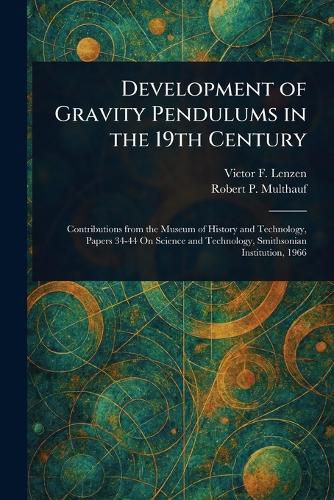Readings Newsletter
Become a Readings Member to make your shopping experience even easier.
Sign in or sign up for free!
You’re not far away from qualifying for FREE standard shipping within Australia
You’ve qualified for FREE standard shipping within Australia
The cart is loading…






This title is printed to order. This book may have been self-published. If so, we cannot guarantee the quality of the content. In the main most books will have gone through the editing process however some may not. We therefore suggest that you be aware of this before ordering this book. If in doubt check either the author or publisher’s details as we are unable to accept any returns unless they are faulty. Please contact us if you have any questions.
Explore the fascinating history and science of timekeeping with "Development of Gravity Pendulums in the 19th Century," a detailed exploration of the pendulum's evolution as a precision instrument. Authored by Victor Fritz Lenzen and Robert P. Multhauf, this meticulously researched work, originally published by the Smithsonian Institution, delves into the physics behind the gravity pendulum and its crucial role in 19th-century measurement.
Part of the Museum of History and Technology's Papers on Science and Technology, this volume offers invaluable insights into the pendulum's development and application. Discover the intricacies of pendulum history, examining its impact on scientific advancement and technological innovation. Perfect for those interested in physics, the history of science, and the evolution of timekeeping, this book provides a comprehensive look at a pivotal technology of the 19th century.
This work has been selected by scholars as being culturally important, and is part of the knowledge base of civilization as we know it.
This work is in the public domain in the United States of America, and possibly other nations. Within the United States, you may freely copy and distribute this work, as no entity (individual or corporate) has a copyright on the body of the work.
Scholars believe, and we concur, that this work is important enough to be preserved, reproduced, and made generally available to the public. We appreciate your support of the preservation process, and thank you for being an important part of keeping this knowledge alive and relevant.
$9.00 standard shipping within Australia
FREE standard shipping within Australia for orders over $100.00
Express & International shipping calculated at checkout
Stock availability can be subject to change without notice. We recommend calling the shop or contacting our online team to check availability of low stock items. Please see our Shopping Online page for more details.
This title is printed to order. This book may have been self-published. If so, we cannot guarantee the quality of the content. In the main most books will have gone through the editing process however some may not. We therefore suggest that you be aware of this before ordering this book. If in doubt check either the author or publisher’s details as we are unable to accept any returns unless they are faulty. Please contact us if you have any questions.
Explore the fascinating history and science of timekeeping with "Development of Gravity Pendulums in the 19th Century," a detailed exploration of the pendulum's evolution as a precision instrument. Authored by Victor Fritz Lenzen and Robert P. Multhauf, this meticulously researched work, originally published by the Smithsonian Institution, delves into the physics behind the gravity pendulum and its crucial role in 19th-century measurement.
Part of the Museum of History and Technology's Papers on Science and Technology, this volume offers invaluable insights into the pendulum's development and application. Discover the intricacies of pendulum history, examining its impact on scientific advancement and technological innovation. Perfect for those interested in physics, the history of science, and the evolution of timekeeping, this book provides a comprehensive look at a pivotal technology of the 19th century.
This work has been selected by scholars as being culturally important, and is part of the knowledge base of civilization as we know it.
This work is in the public domain in the United States of America, and possibly other nations. Within the United States, you may freely copy and distribute this work, as no entity (individual or corporate) has a copyright on the body of the work.
Scholars believe, and we concur, that this work is important enough to be preserved, reproduced, and made generally available to the public. We appreciate your support of the preservation process, and thank you for being an important part of keeping this knowledge alive and relevant.